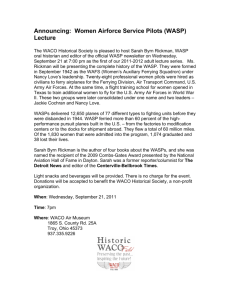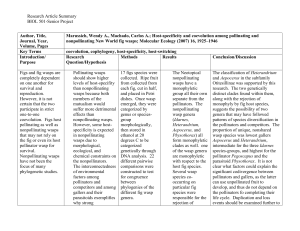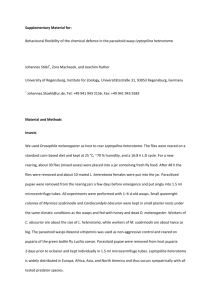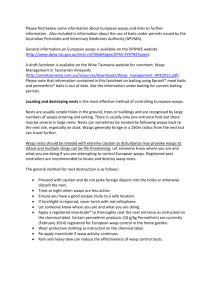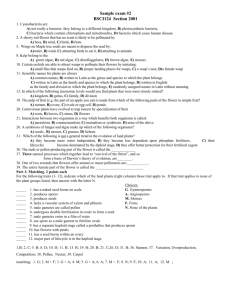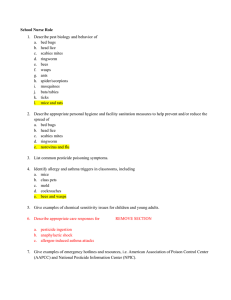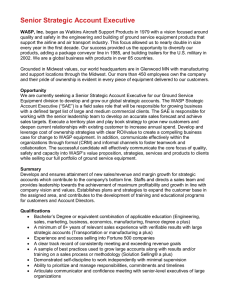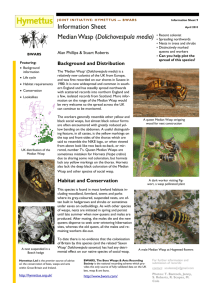The role of age in temporal polyethism in a primitively...
advertisement
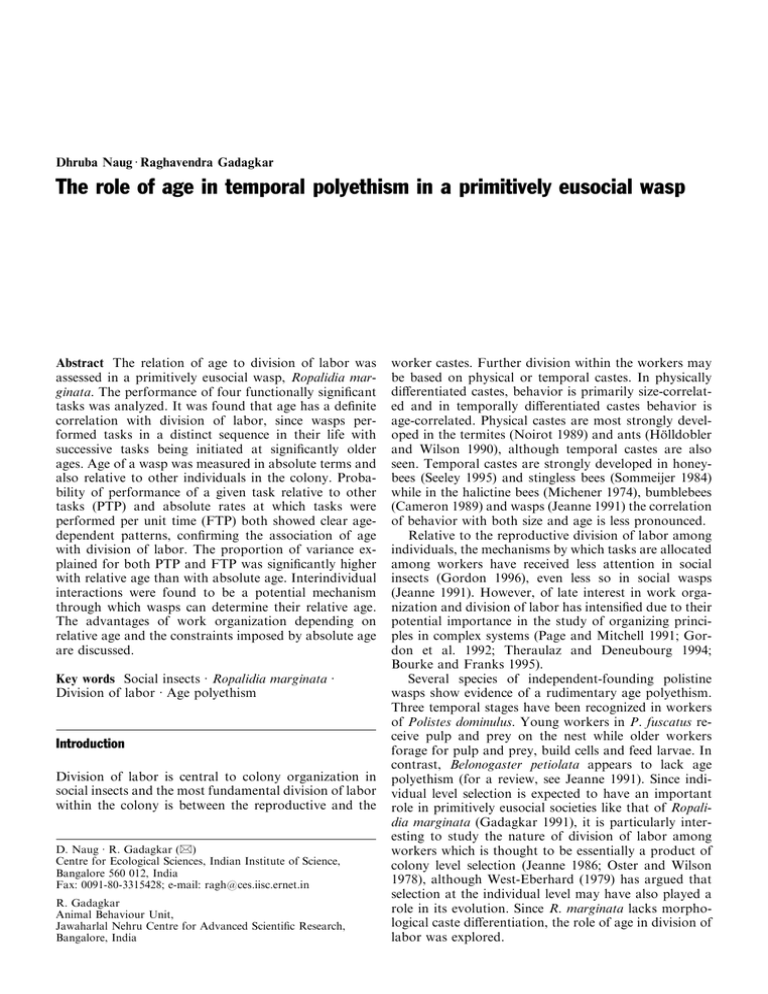
Dhruba Naug á Raghavendra Gadagkar The role of age in temporal polyethism in a primitively eusocial wasp Abstract The relation of age to division of labor was assessed in a primitively eusocial wasp, Ropalidia marginata. The performance of four functionally signi®cant tasks was analyzed. It was found that age has a de®nite correlation with division of labor, since wasps performed tasks in a distinct sequence in their life with successive tasks being initiated at signi®cantly older ages. Age of a wasp was measured in absolute terms and also relative to other individuals in the colony. Probability of performance of a given task relative to other tasks (PTP) and absolute rates at which tasks were performed per unit time (FTP) both showed clear agedependent patterns, con®rming the association of age with division of labor. The proportion of variance explained for both PTP and FTP was signi®cantly higher with relative age than with absolute age. Interindividual interactions were found to be a potential mechanism through which wasps can determine their relative age. The advantages of work organization depending on relative age and the constraints imposed by absolute age are discussed. Key words Social insects á Ropalidia marginata á Division of labor á Age polyethism Introduction Division of labor is central to colony organization in social insects and the most fundamental division of labor within the colony is between the reproductive and the D. Naug á R. Gadagkar (&) Centre for Ecological Sciences, Indian Institute of Science, Bangalore 560 012, India Fax: 0091-80-3315428; e-mail: ragh@ces.iisc.ernet.in R. Gadagkar Animal Behaviour Unit, Jawaharlal Nehru Centre for Advanced Scienti®c Research, Bangalore, India worker castes. Further division within the workers may be based on physical or temporal castes. In physically dierentiated castes, behavior is primarily size-correlated and in temporally dierentiated castes behavior is age-correlated. Physical castes are most strongly developed in the termites (Noirot 1989) and ants (HoÈlldobler and Wilson 1990), although temporal castes are also seen. Temporal castes are strongly developed in honeybees (Seeley 1995) and stingless bees (Sommeijer 1984) while in the halictine bees (Michener 1974), bumblebees (Cameron 1989) and wasps (Jeanne 1991) the correlation of behavior with both size and age is less pronounced. Relative to the reproductive division of labor among individuals, the mechanisms by which tasks are allocated among workers have received less attention in social insects (Gordon 1996), even less so in social wasps (Jeanne 1991). However, of late interest in work organization and division of labor has intensi®ed due to their potential importance in the study of organizing principles in complex systems (Page and Mitchell 1991; Gordon et al. 1992; Theraulaz and Deneubourg 1994; Bourke and Franks 1995). Several species of independent-founding polistine wasps show evidence of a rudimentary age polyethism. Three temporal stages have been recognized in workers of Polistes dominulus. Young workers in P. fuscatus receive pulp and prey on the nest while older workers forage for pulp and prey, build cells and feed larvae. In contrast, Belonogaster petiolata appears to lack age polyethism (for a review, see Jeanne 1991). Since individual level selection is expected to have an important role in primitively eusocial societies like that of Ropalidia marginata (Gadagkar 1991), it is particularly interesting to study the nature of division of labor among workers which is thought to be essentially a product of colony level selection (Jeanne 1986; Oster and Wilson 1978), although West-Eberhard (1979) has argued that selection at the individual level may have also played a role in its evolution. Since R. marginata lacks morphological caste dierentiation, the role of age in division of labor was explored. Methods Behavioral observations were conducted on ®ve postemergence colonies of R. marginata maintained in a vespiary in the Indian Institute of Science campus in Bangalore, India. Each wasp was uniquely marked with a color code on the day of eclosion enabling determination of the age of each wasp on each day of observation. Behavioral observations on these colonies consisted of recording every occurrence (``all-occurrence sampling''; Altmann 1974; Gadagkar and Joshi 1983), of each of the ®ve behaviors, ``Feed Larva'', ``Build'', ``Bring Pulp'', ``Bring Food'' and ``Solicit'' (for de®nitions and rationale for choosing these ®ve behaviors, see below). All sampling sessions were randomly chosen between 0630 and 1830 hours. Each sampling day had three sessions of 2 h each and the time of the sessions alternated between successive days of observation to cover the whole span of daylight hours. In each 2 h session, ®fteen 5-min all-occurrence samplings were carried out, resulting in 225 min of sampling per day. Observations were made on colony L64 (colony size:10±16 wasps) between 12 September and 7 November 1993 yielding 120 h of data, on colonies N327 (24±70 wasps) and V106 (13±25 wasps) between 23 February and 6 May 1994, and on colonies L65 (22±34 wasps) and N360 (15±34 wasps) between 29 October and 29 December 1995, each of these four colonies yielding 60 h of data. All wasps were classi®ed into 1-day age groups based on their absolute or relative age. Relative age is the ranked age of a wasp and is a measure of its position in the age distribution of the colony. These ranks were computed on each day of observation for each wasp based on its absolute age. The youngest wasp was assigned a rank of one and wasps of successive ages were assigned successive ranks with the oldest wasp obtaining the highest rank equal to the number of individuals in the colony on that day. Wasps of the same age were assigned tied ranks. The range was then scaled between 0 and 100 by using the equation: SRi Ri ÿ 1 100 N ÿ1 where SRi Scaled rank of a wasp i Ri Rank of a wasp i N Number of individuals in the colony. This scaling corrected for dierences in number of individuals present in the colony on dierent days. To test if the wasps could use interindividual interactions to assess their relative positions in the age distribution in the colony, an interaction score was calculated for each wasp as a ratio between the number of times it took part in a ``Solicit'' with individuals younger than itself and the total number of solicits it was involved in on each day. Solicit is de®ned as a mouth-to-mouth contact between two wasps without any obvious exchange of food. Both directions of the behavior (Solicit and Being Solicited) were considered while calculating this ratio. The performance, by wasps of various ages, of four commonly observed tasks that have clear functional signi®cance was analyzed to determine if there was any temporal division of labor. Of these four, two tasks are intranidal: ``Feed Larva'' and ``Build'' while two are extranidal: ``Bring Pulp'' and ``Bring Food''. Feed Larva is the act of feeding solid food to the developing larvae by the adult workers. Build consists of construction activity involving building new cells and breaking or extending walls of old cells. Bring Pulp is the act of foragers returning with building material while Bring Food is the act of foragers returning with food. The combined intranidal tasks (Feed Larva + Build) and extranidal tasks (Bring Pulp + Bring Food) were also analyzed similarly. First performance of a task is de®ned as the ®rst observed performance of the task by a given wasp since its eclosion. Age of each wasp during the ®rst performance of a task was used to determine the sequence in which wasps initiated performance of different tasks in their lifetime. Using the number of times each task was performed during the 225 min of sampling in a day, task performance for each individual of a given age was calculated. Two measures of task performance were used: 1. Probability of task performance (PTP) is the probability that a worker of a given age will perform a given task, relative to other tasks it performs (Seeley 1982), and is calculated as: pij nij k P nij i1 where pij Probability of performance of the task i by a member of age j, nij Total number of times task i was performed by members of age j and k Number of tasks being considered. 2. Frequency of task performance (FTP) is the rate (number of times per hour) at which a worker of a given age performs a task. One-way ANOVA and Mann-Whitney U-test were used to test the eect of age on the ®rst performance of a task. Using polynomial equations, each measure of task performance (PTP and FTP) was regressed on each measure of age (absolute and relative). The regressions were performed for each colony separately, using all the individuals of all the ages. F-test was used to calculate the signi®cance of the ®tted polynomials. Wilcoxon's signed-ranks test was used to compare the variance explained (r2 ) for the two measures of task performance by the two measures of age according to the respective polynomial regression models. Results Several lines of evidence indicate that the task performance of a wasp is signi®cantly correlated with its age. Data from the ®ve nests were pooled to look at the sequence and age of ®rst performance. Of the 39 wasps seen to do both intra- and extranidal tasks no wasp did an extranidal task before doing an intranidal task. For those that were observed to perform at least one task, Feed Fig. 1 The most common sequence in which the four tasks are performed was analyzed in two dierent ways. The numbers above each box represent the observed proportions of wasps that performed the task in that position, independent of what they did at any other position. Thus, out of 159 wasps that did at least one task, 136 did Feed Larva as their ®rst task; of 100 wasps that did at least two tasks, 79 did Build as their second task, and so on. Each of these proportions are signi®cantly dierent from the proportion expected (1/4) if wasps were taking up tasks at random (G 258:86, 128.32, 29.91 and 32.04 respectively, P < 0:001). The numbers below each box at the head of the arrow represent the observed proportions of wasps that followed the particular sequence corresponding to the arrow. Thus, out of 61 wasps that did only two tasks, 48 followed the sequence Feed Larva, Build, of 24 wasps that did only 3 tasks in their life, 12 followed the sequence Feed Larva, Build, Bring Pulp, and so on. Since there are four tasks to choose from, the expected probability of a sequence with two tasks is 1/12 and that of a sequence with three or four tasks is 1/ 24. The observed proportions of sequences with two, three and four tasks were signi®cantly dierent from those expected at P < 0:001 (G 177:61, G 44:02 and G 61:51 respectively) Fig. 2 Mean ( SD) age of ®rst performance for each task in terms of absolute age (open bars) and relative age (shaded bars). Sample size for each task is given above the respective bars. Multiple comparisons of mean ages of ®rst performance using Tukey-Kramer method indicated signi®cant dierences across tasks (P < 0:05). The ®rst performance of a task was signi®cantly in¯uenced by absolute age (one-way ANOVA, F 33:47, P < 0:0001) and relative age (F 49:12, P < 0:0001). Mean ages for successive tasks were also signi®cantly dierent (P < 0:05) by a Mann-Whitney U-test Fig. 3 Probability of task performance (PTP) as a function of absolute age ®tted with secondorder polynomial regression lines. Data points represent the mean value for all individuals in that age class in ®ve colonies. a Intranidal tasks (y 0:92ÿ0:001x ÿ 5:47 10ÿ5 x2 , r2 0:38, P < 0:0001). b Feed Larva (y 0:70 ÿ 0:007x 5:54 10ÿ5 x2 , r2 0:12, P < 0:005). c Build (y 0:22 0:006xÿ 1:10 10ÿ4 x2 , r2 0:26, P < 0:0001). d Extranidal tasks (y 0:07 0:001x 5:47 10ÿ5 x2 , r2 0:38, P < 0:0001). e Bring Pulp (y 0:03 5:74 10ÿ4 xÿ 1:32 10ÿ5 x2 , r2 0:14, P < 0:005). f Bring Food (y 0:03 4:69 10ÿ4 x 6:80 10ÿ5 x2 , r2 0:42, P < 0:0001). In all cases, df 81 Fig. 4 Probability of task performance (PTP) as a function of relative age ®tted with secondorder polynomial regression lines. Data points represent the mean value for all individuals in that age class in ®ve colonies. a Intranidal tasks (y 0:99ÿ 5:21 10ÿ4 xÿ 3:73 10ÿ5 x2 , r2 0:75, P < 0:0001). b Feed Larva (y 0:93 ÿ 0:01x 7:93 10ÿ5 x2 , r2 0:55, P < 0:0001). c Build (y 0:06 0:01x ÿ 1:16 10ÿ4 x2 , r2 0:30, P < 0:0001). d Extranidal tasks (y 3:84 10ÿ4 5:21 10ÿ4 x 3:73 10ÿ5 x2 , r2 0:75, P < 0:0001). e Bring Pulp (y ÿ0:01 0:003xÿ 2:9 10ÿ5 x2 , r2 0:34, P < 0:0001). f Bring Food (y 0:01 ÿ 0:002x 6:63 10ÿ5 x2 , r2 0:76, P < 0:0001). In all cases, df 99 Larva was predominantly the ®rst task after eclosion. For those that were observed to perform at least two, three, or four tasks, Build, Bring Pulp and Bring Food were the most common second, third and fourth tasks respectively (Fig. 1). Considering the actual sequence of task performance explicitly, the sequence Feed Larva, Build, Bring Pulp and Bring Food is the most commonly observed sequence (Fig. 1). In addition, there was a signi®cant eect of both absolute age and relative age on the ®rst performance of a task (one-way ANOVA, P < 0:0001), each successive task in the sequence being initiated at signi®cantly higher ages (Fig. 2). The extent of performance of a task was found to either increase with age, decrease with age, or peak in middle age. Second- or higher-order polynomial equations that can model all these possibilities were therefore a natural choice to regress each measure of task performance on each measure of age. Although second- and third-order polynomial equations gave identical results in the comparison of the variance explained by absolute and relative ages, data for only the second-order polynomials are presented. Probability of task performance (PTP) measures the tendency of wasps of a given age to perform a given task relative to their performance of other tasks. The probability of doing intranidal tasks decreases with age while that of doing extranidal tasks increases. The probability of Feed Larva decreases with age, that of Build and Bring Pulp peak in middle age while the probability of Bring Food increases with age. All these qualitative patterns are identical for both absolute (Fig. 3) and relative ages (Fig. 4). Fig. 5 Frequency of task performance (FTP) as a function of absolute age ®tted with second-order polynomial regression lines. Data points represent the mean value for all individuals in that age class in ®ve colonies. a Intranidal tasks (y 0:91 ÿ 0:004xÿ 1:06 10ÿ5 x2 , r2 0:14, P < 0:005). b Feed Larva (y 0:61 ÿ 0:006x 6:36 10ÿ5 x2 , r2 0:02, P > 0:05). c Build (y 0:30 0:002x ÿ 7:43 10ÿ5 x2 , r2 0:32, P < 0:0001). d Extranidal tasks (y 0:08 0:002x 1:92 10ÿ5 x2 , r2 0:24, P < 0:0001). e Bring Pulp (y 0:06 2:99 10ÿ4 xÿ 1:45 10ÿ5 x2 , r2 0:20, P < 0:0001). f Bring Food (y 0:01 0:001x 3:37 10ÿ5 x2 , r2 0:33, P < 0:0001). In all cases, df 81 When PTP was regressed over relative age, a higher amount of variation in the data could be explained by the regression models than when absolute age was used. A comparison of the r2 values obtained for the four tasks in each of the ®ve colonies showed that those obtained with relative age were signi®cantly higher than the corresponding ones obtained with absolute age (Ts 5, n 20, P < 0:01). This shows that the probability with which a wasp performs one task relative to other tasks is more strongly related to its relative age in the colony than with its absolute age. Frequency of task performance is an absolute measure of task performance and quanti®es the actual contribution to the colony labor by a given age. The variation in FTP as a function of age depended on whether absolute or relative age was used as the measure of age. When absolute age was used (Fig. 5), the frequency of performing intranidal tasks decreases with age and that of extranidal tasks increases. The frequencies of Build and Bring Pulp decrease with age, that of Bring Food increases while the frequency of Feed Larva does not change appreciably with age. When relative age was used (Fig. 6), the frequency of performing intranidal tasks peaks in middle age and that of performing extranidal tasks increases with age. The frequency of Feed Larva decreases with age, frequencies of Build and Bring Pulp peak in middle age and the frequency of Bring Food increases with age. As in the case of PTP, relative age explains a higher amount of variance in the data than absolute age does Fig. 6 Frequency of task performance (FTP) as a function of relative age ®tted with second-order polynomial regression lines. Data points represent the mean value for all individuals in that age class in ®ve colonies. a Intranidal tasks (y 0:70 0:01xÿ 1:84 10ÿ4 x2 , r2 0:28, P < 0:0001). b Feed Larva (y 0:66 ÿ 0:001xÿ 2:12 10ÿ5 x2 , r2 0:21, P < 0:0001). c Build (y 0:03 0:01xÿ 1:62 10ÿ4 x2 , r2 0:39, P < 0:0001). d Extranidal tasks (y ÿ0:03 0:005xÿ 2:44 10ÿ5 x2 , r2 0:48, P < 0:0001). e Bring Pulp (y ÿ0:02 0:005xÿ 5:10 10ÿ5 x2 , r2 0:30, P < 0:0001). f Bring Food (y ÿ0:007 2:16 10ÿ4 x 2:66 10ÿ5 x2 , r2 0:63, P < 0:0001). In all cases, df 99 Fig. 7 Relative age of an individual wasp is positively correlated with its interaction score (s 0:651, n 2736, P < 0:001) (Ts 24, n 20, P < 0:01). Therefore, the actual magnitude of task performance is also better correlated with relative age than with absolute age of a wasp. To test the hypothesis that interindividual interactions could be a proximate mechanism by which wasps may assess their relative age, Solicit was used as a measure of interaction since it is the most frequent interaction in a colony and therefore the most reliable one a wasp can potentially use to assess its position in the colony age distribution. The relative age of an individual was signi®cantly correlated with its interaction score (Fig. 7), suggesting that interaction score is a good indicator of relative age. When PTP (Fig. 8) and FTP (Fig. 9) were regressed against interaction score, a signi®cant amount of variation in the data could be explained and the patterns of task performance for all the Fig. 8 Probability of task performance (PTP) as a function of interaction score ®tted with second-order polynomial regression lines. Data points represent the mean value for all individuals with the same interaction score in ®ve colonies. a Intranidal tasks (y 0:95ÿ 5:76 10ÿ4 xÿ 4:70 10ÿ5 x2 , r2 0:43, P < 0:0001). b Feed Larva (y 0:74 ÿ 0:008x 5:33 10ÿ5 x2 , r2 0:19, P 0:0001). c Build (y 0:21 0:008x ÿ 1:003 10ÿ4 x2 , r2 0:14, P < 0:001). d Extranidal tasks (y 0:04ÿ 5:76 10ÿ4 x 4:70 10ÿ5 x2 , r2 0:43, P < 0:0001). e Bring Pulp (y ÿ0:006 0:003xÿ 3:2 10ÿ5 x2 , r2 0:19, P 0:0001). f Bring Food (y 0:04 ÿ 0:003x 7:96 10ÿ5 x2 , r2 0:49, P < 0:0001). In all cases, df 93 tasks were identical to those obtained when they were regressed against relative age. Discussion In spite of a large interindividual variability (Gadagkar and Joshi 1983), there is nevertheless a clear underlying pattern of age polyethism in the primitively eusocial wasp R. marginata. This demonstration of age polyethism in R. marginata is based on several analytical approaches, the results of which are consistent with each other. The sequence analysis demonstrates that workers have an ontogenetic sequence of task performance. Even if wasps follow a de®nite sequence of task performance in their life, it does not necessarily follow that when data on a number of individuals, especially from dierent colonies, are pooled, there should be a signi®cant difference in the age of ®rst performance of successive tasks. That we ®nd such a signi®cant dierence is evidence of a strong eect of age on task performance. PTP and FTP, which assess the actual extent of task performance, are useful complements to each other since workers could be the same in terms of one while diering in the other. This study represents the strongest demonstration so far, of the relation of age with division of labor for any primitively eusocial species. R. marginata has no morphological caste dierentiation, leaving the workers with a future reproductive option (Gadagkar 1991, 1996). The strong relation of age with division of labor seen in this species suggests that age polyethism can evolve even before workers have lost their reproductive options. Fig. 9 Frequency of task performance (FTP) as a function of interaction score ®tted with second-order polynomial regression lines. Data points represent the mean value for all individuals with the same interaction score in ®ve colonies. a Intranidal tasks (y 0:78 0:009x ÿ 1:30 10ÿ4 x2 , r2 0:13, P < 0:005). b Feed Larva (y 0:55ÿ 3:91 10ÿ4 xÿ 1:15 10ÿ5 x2 , r2 0:02, P > 0:05). c Build (y 0:22 0:01x ÿ 1:19 10ÿ4 x2 , r2 0:20, P < 0:0001). d Extranidal tasks (y 0:003 0:004x ÿ 2:008 10ÿ5 x2 , r2 0:34, P < 0:0001). e Bring Pulp (y 0:004 0:004xÿ 5:19 10ÿ5 x2 , r2 0:22, P < 0:0001). f Bring Food (y ÿ 6:38 10ÿ4 ÿ 1:17 10ÿ4 x 3:19 10ÿ5 x2 , r2 0:45, P < 0:0001). In all cases, df 93 Bourke and Franks (1995) argue that most studies on age polyethism are made over short periods and look at age-cohorts rather than the lifetime careers of individuals, and this generates an impression of age-based division of labor that is in fact spurious. The present study involved simultaneous observation of individuals of all available ages made over a period of time longer than the lifespan of workers (27 21 days). Hence, the distinct sequence in which wasps take up dierent tasks in their life and a signi®cant increase in age as they move from one task to the next makes it unlikely that age polyethism emerges here as an artefact from sampling drawbacks. A highly signi®cant pattern is seen in the sequence of ®rst performance of a task despite the fact that the ®rst performance of a task is a single point in time that can be easily missed due to limitations of sampling. Another criticism of Bourke and Franks (1995), that laboratory colonies are distorted in terms of size, internal geometry, and age structure is also not applicable to this study since the colonies used were natural and free-foraging. It is true that the demonstration of a correlation of age with task performance does not necessarily mean that age is a causative factor. As an alternative to age as a causative factor, the ``foraging for work'' hypothesis (Tofts and Franks 1992) assumes that tasks are spatially ordered in the nest (Franks and Sendova-Franks 1992) and workers have spatial ®delity zones (Sendova-Franks and Franks 1995a,b). However, in R. marginata, these assumptions do not seem to hold since (a) the queen does not lay eggs at a single point on the nest, (b) the workers do not sort brood, and (c) both the queen and the workers move about the entire nest surface during every day of their life. The observed sequence of task performance bears a logical biological interpretation. That wasps begin their life with intranidal tasks is not surprising. In highly eusocial insects where workers have few or no reproductive options, colony level selection will favor such a pattern as each individual will be available to the colony for the highest possible period (Jeanne 1986). In a species such as R. marginata where workers have substantial reproductive options (Gadagkar 1996), both individual and colony level selection may be expected to favor such a pattern. Within intranidal tasks, Feed Larva precedes Build and within extranidal tasks, Bring Pulp precedes Bring Food perhaps because Feed Larva and Bring Pulp require less skill and experience than Build and Bring Food respectively. Fig. 10 Fitted polynomial regression lines for PTP against a absolute age, b relative age, and c interaction score and FTP over d absolute age, e relative age, and f interaction score for all four tasks. The ®tted lines for all tasks are plotted together on the same scale to show the overlap of performance of different tasks across age. Thin broken lines refer to Feed Larva, thick broken lines to Build, thin solid lines to Bring Pulp and thick solid lines to Bring Food. Note that there is more overlap in the age of individuals engaged in Build and Bring Pulp while this overlap is less when the tasks Feed Larva and Bring Food are considered The tasks Build and Bring Pulp are handled by wasps of similar ages while the tasks Feed Larva and Bring Food are handled by rather dierent age groups (Fig. 10) although both these pairs of tasks consist of an intranidal task preceded by its complementary extranidal task. However, the performance of Build and Bring Pulp by similar age groups in R. marginata is unlikely to improve spatial eciency as suggested by Wilson (1976) and Seeley (1982) for ants and bees respectively, since one of these two tasks is intranidal and the other extranidal. Alternatively, since pulp is an inert and static resource unlike food which is a more costly and ephemeral resource, there may be stronger selection for wasps to partition prey handling tasks among dierent individuals than to partition pulp handling tasks (Post et al. 1988). The results reported here suggest that the relative allocation of a wasp's work budget into various tasks as well as the rate of performance of each task depends more on its relative age than on its absolute age. Notice that this conclusion is not an artefact of the kind of equations used for the regressions since it is seen with both second- and third-order polynomials. It is thus expected that the age distribution in the colony will have a strong in¯uence on the PTP and FTP of a wasp. A work organization based on such relative age dependent task allocation will be more ¯exible permitting a colony to cope with changes in age distribution due to demographic and ecological factors, that may especially prevail in small colonies. In a work organization based on relative age, the task allocation pro®le of an individual will depend on the task allocation pro®les of other wasps and therefore such an organization can be self-regulatory, cutting down on super¯uous workers for a task and ensuring at least some workers for all tasks at all times. These advantages of a relative-age-based work organization cannot be paralleled by an organization based on absolute age. The idea of relative age is consistent with other results from honey bees and ants which show that task pro®les of individuals depend on the age distribution of the colony (Huang and Robinson 1992; Page et al. 1992), or on the numbers of individuals engaged in dierent tasks (Gordon 1989). Using age to select tasks need not be a highly static method of task allocation as suggested by Tofts and Franks (1992) if what a worker does is more dependent on its relative age rather than its absolute age. Although relative age explains a greater proportion of the variance in the data both for PTP and FTP, the dierence between absolute and relative ages in explaining the variance in the data is more pronounced for PTP (Ts 5, n 20) than it is for FTP (Ts 24, n 20). It seems therefore that there are more constraints on the ability of wasps to adjust their FTP according to their relative age than on their ability to adjust their PTP. This is probable because it may be easier for wasps of any age to shift from one task to another rather than to alter their rates of work. Calderone and Page (1991) have similarly argued that variation in the temporal pattern of task performance can be independent of the proportion of time spent in performing dierent tasks. If the wasps follow a temporal division of labor based on their relative age, they need to regularly evaluate their position in the colony age distribution. This requires that the wasps have some mechanism of assessing the number of wasps older and younger than themselves. The results that there is a signi®cant correlation of relative age with interaction score and that the pattern of variation in PTP and FTP with interaction scores is identical to their variation with relative age are consistent with (but do not necessarily prove) the hypothesis that wasps could assess their relative age by weighing the number of interactions with individuals younger than themselves against the total number of interactions they are involved in. The ®nding that what a wasp does is more dependent on its relative age than its absolute age, and that a wasp can potentially assess its relative age by its interaction score, is consistent with the activator-inhibitor model of Huang and Robinson (1992) in which plasticity in temporal polyethism is generated by worker-worker interactions. Acknowledgements We thank HS Arathi, NV Joshi, JA Santosh and A Sinha for many helpful discussions, Nigel Franks, Deborah Gordon, Robert Jeanne, Gene Robinson and three anonymous referees for reviewing an earlier version of the manuscript and Department of Science and Technology and Ministry of Environment and Forests, Government of India for ®nancial support. References Altmann J (1974) Observational study of behavior: sampling methods. Behaviour 49:227±265 Bourke AFG, Franks NR (1995) Social evolution in ants. Princeton University Press, Princeton Calderone NW, Page RE (1991) Evolutionary genetics of division of labor in colonies of the honey bee (Apis mellifera). Am Nat 138:69±92 Cameron SA (1989) Temporal patterns of division of labor among workers in the primitively eusocial bumble bee, Bombus griseocollis. Ethology 80:137±151 Franks NR, Sendova-Franks AB (1992) Brood sorting by ants: distributing the workload over the work surface. Behav Ecol Sociobiol 30:109±123 Gadagkar R (1991) Belonogaster, Mischocyttarus, Parapolybia, and independent founding Ropalidia. In: Ross KG, Matthews RW (eds) The social biology of wasps. Comstock, Ithaca, pp 149±190 Gadagkar R (1996) The evolution of eusociality, including a review of the social status of Ropalidia marginata. In: Turillazzi S, West-Eberhard MJ (eds) Natural history and the evolution of paper wasps. Oxford University Press, Oxford, pp 248±271 Gadagkar R, Joshi NV (1983) Quantitative ethology of social wasps: time-activity budgets and caste dierences in Ropalidia marginata (L.). Anim Behav 31:26±31 Gordon DM (1989) The dynamics of task switching in harvester ants. Anim Behav 38:194±204 Gordon DM (1996) The organization of work in social insect colonies. Nature 380:121±124 Gordon DM, Goodwin BC, Trainor LEH (1992) A parallel distributed model of the behaviour of ant colonies. J Theor Biol 156:293±307 HoÈlldobler B, Wilson EO (1990) The ants. Belknap, Cambridge Huang Z, Robinson GE (1992) Honeybee colony integration: worker-worker interactions mediate hormonally regulated plasticity in division of labor. Proc Natl Acad Sci USA 89:11726±11729 Jeanne RL (1986) The evolution of the organization of work in social insects. Monit Zool Ital 20:119±133 Jeanne RL (1991) Polyethism. In: Ross KG, Matthews RW (eds) The social biology of wasps. Comstock, Ithaca, pp 389±425 Michener CD (1974) The social behavior of the bees: a comparative study. Belknap, Cambridge Noirot C (1989) Social structure in termite societies. Ethol Ecol Evol 1:1±17 Oster GF, Wilson EO (1978) Caste and ecology in the social insects. Princeton University Press, Princeton Page RE, Mitchell SD (1991) Self organization and adaptation in insect societies. In: Fine A, Forbes M, Wessels L (eds) PSA 1990 vol 2. Philosophy of Science Association, East Lansing, pp 289±298 Page RE, Robinson GE, Britton DS, Fondrk MK (1992) Genotypic variability for rates of behavioral development in worker honey bees (Apis mellifera L.). Behav Ecol 3:173±180 Post DC, Jeanne RL, Erickson EH (1988) Variation in behavior among workers of the primitively social wasp Polistes fuscatus variatus. In: Jeanne RL (ed) Interindividual behavioral variability in social insects. Westview, Boulder, pp 283±322 Seeley TD (1982) Adaptive signi®cance of the age polyethism schedule in honeybee colonies. Behav Ecol Sociobiol 11:287± 293 Seeley TD (1995) The wisdom of the hive: the social physiology of honey bee colonies. Harvard University Press, Cambridge Sendova-Franks AB, Franks NR (1995a) Spatial relationships within nests of the ant Leptothorax unifasciatus (Latr.) and their implications for the division of labour. Anim Behav 50:121±136 Sendova-Franks AB, Franks NR (1995b) Demonstrating new social interactions in ant colonies through randomization tests: separating seeing from believing. Anim Behav 50:1683± 1696 Sommeijer MJ (1984) Distribution of labor among workers of Melipona favosa: age polyethism and worker oviposition. Insectes Soc 31:171±184 Theraulaz G, Deneubourg JL (1994) Swarm intelligence in social insects and the emergence of cultural swarm patterns. In: Gardner A, Chiarelli AB, Gardner BT, Ploojd FX (eds) The ethological roots of culture. NATO ASI Proceedings, North Holland, Amsterdam Tofts C, Franks NR (1992) Doing the right thing: ants, honeybees and naked mole-rats. Trends Ecol Evol 7:346±349 West-Eberhard MJ (1979) Sexual selection, social competition, and evolution. Proc Am Philos Soc 123:222±234 Wilson EO (1976) Behavioral discretization and the number of castes in an ant species. Behav Ecol Sociobiol 1:141±154
